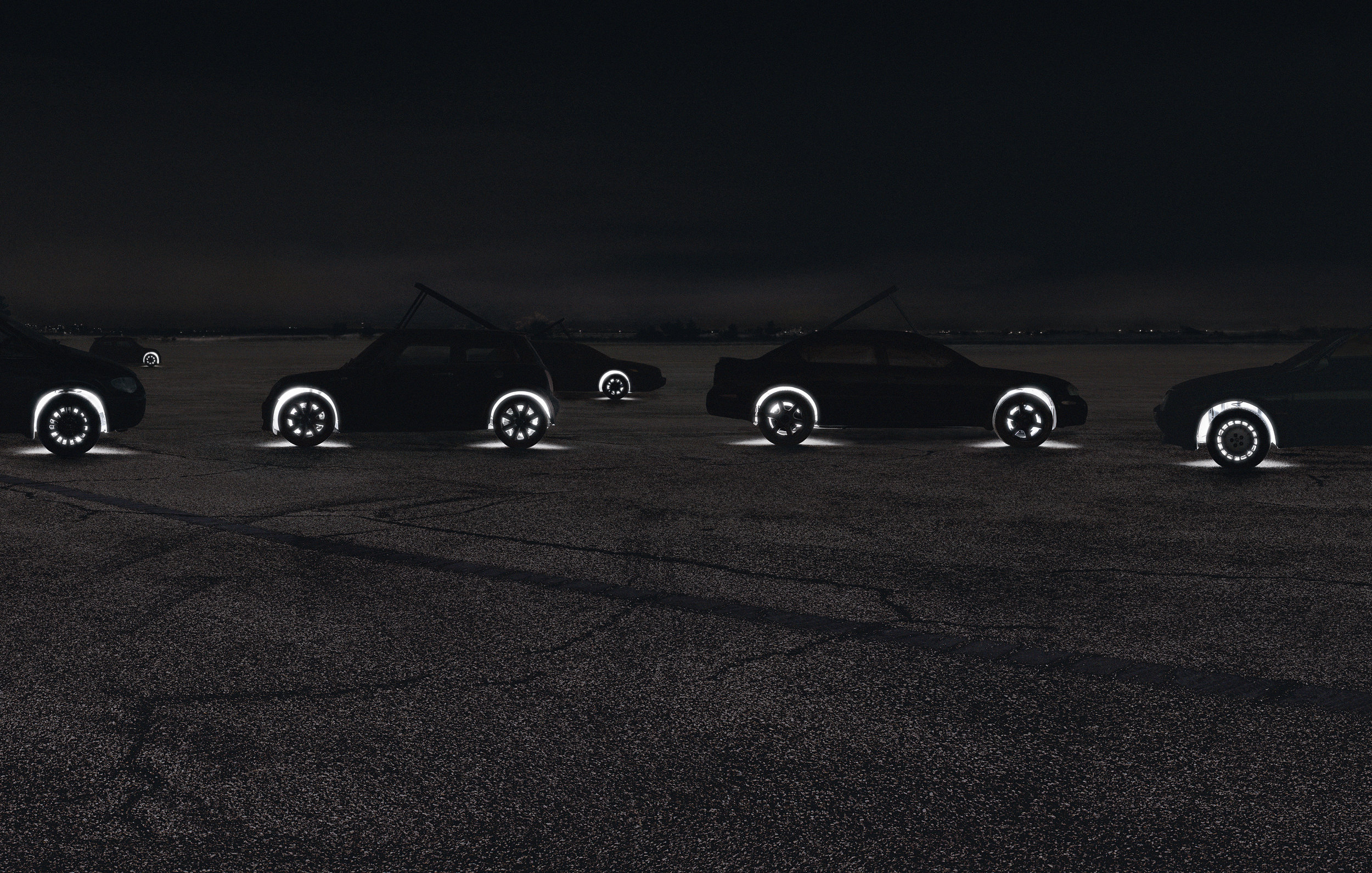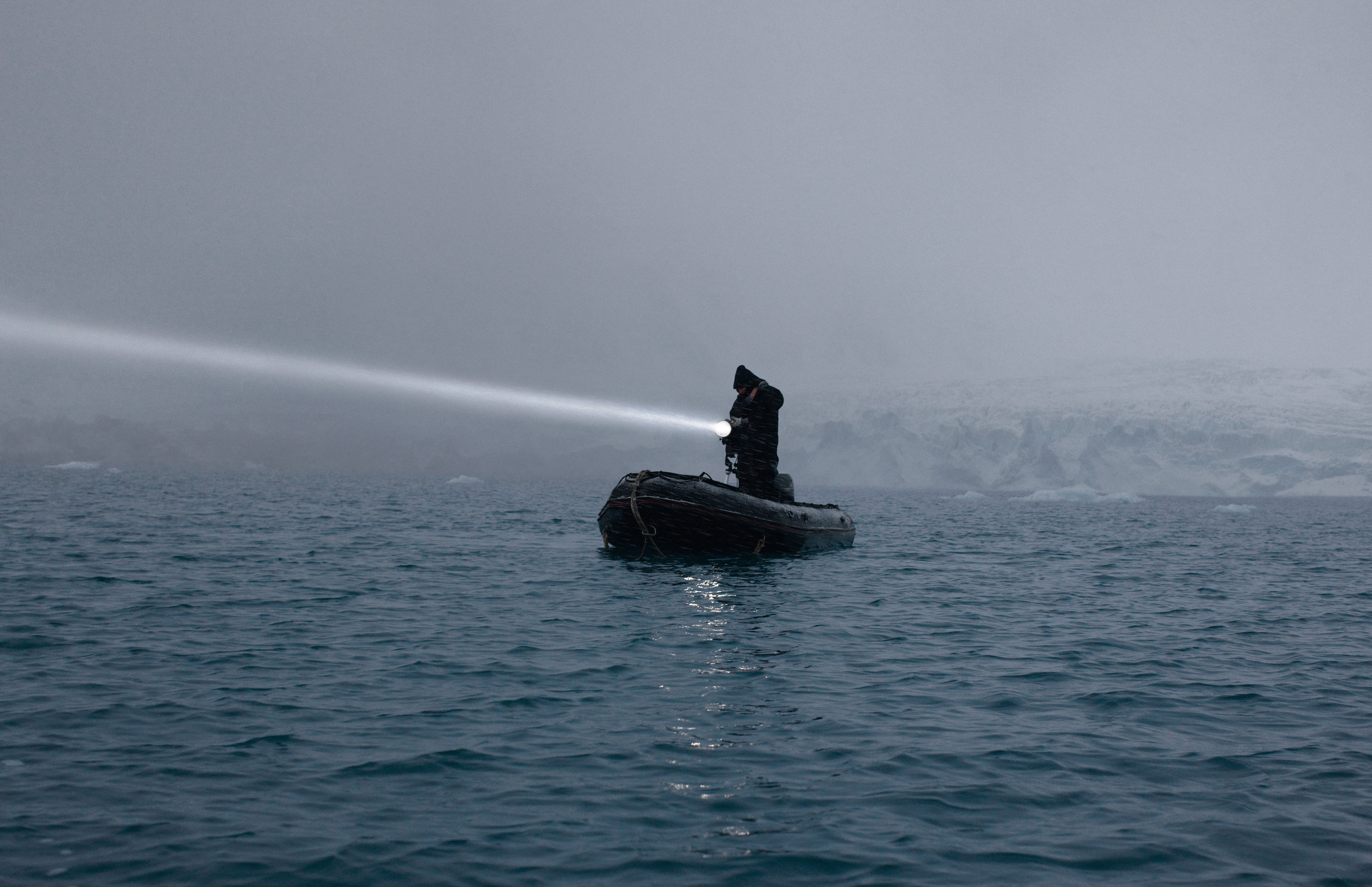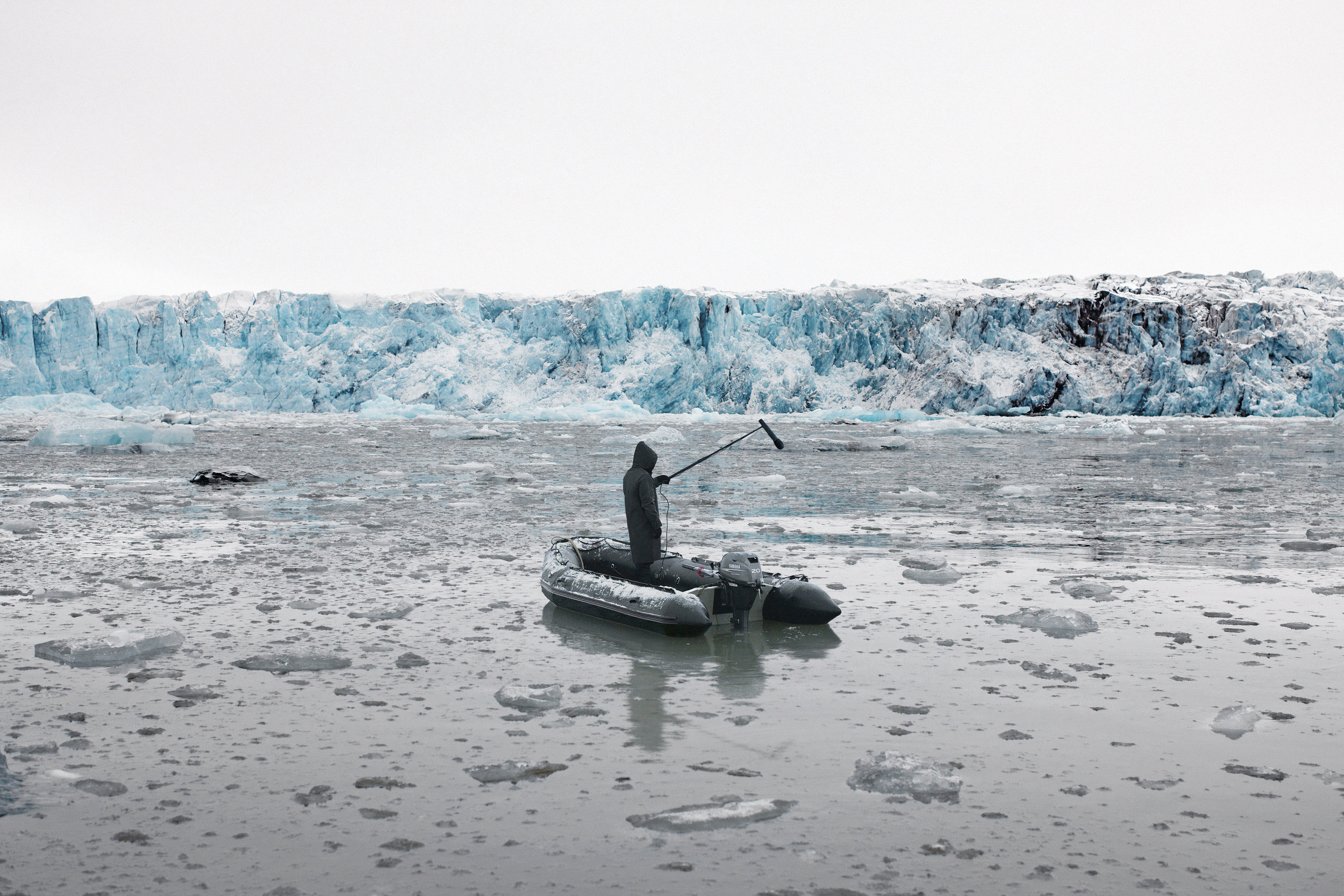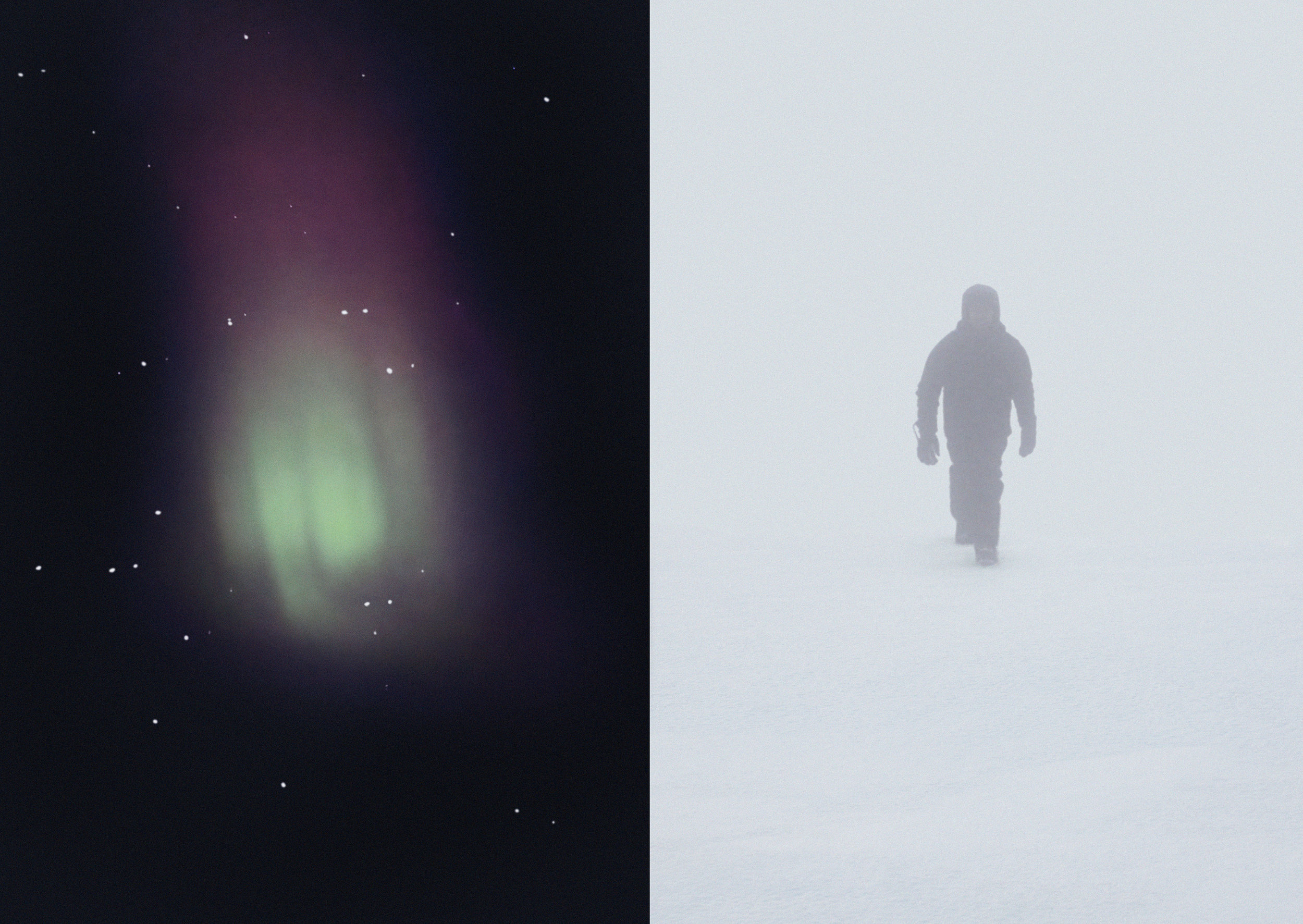IX
Andrea Galvani © Higgs Ocean #1, 2009
C-print mounted on aluminum dibond
White wood frame
Approx. 83 x 103 cm / 32.7 x 40.5 inches
HIGGS OCEAN
"Once it has pierced through the sky and gone through the last layer of the atmosphere, unobstructed light is able to travel infinitely, to the farthest reaches of space."
The Higgs Ocean project documents a unique action staged off the coast of the Svalbard Islands in the Arctic Circle. It required the collaboration of a research institute, two scientists and a crew of 16 people, and was born out of four months of study and preparation with a group of New York-based Russian engineers. Over the course of the 2,800 km sail, the artist used photovoltaic panels to collect and store the natural energy of the limited daily sunlight. He used the accumulated energy to power a flashlight capable of projecting a beam of light over 200,000 ANSI lumens strong. The beam cracked through the Arctic landscape like a bolt of lightning and pierced through the Earth’s atmosphere; within a few minutes, a luminescent memory of the artist’s journey had been returned to the Universe. Each photograph in the series records a singular moment in this transfer of energy—simulacra of a process that continues, segments of an infinite vector.
Andrea Galvani © Higgs Ocean #5, 2009
C-print mounted on aluminum dibond
Black wood frame
158 x 238 x 7 cm / 62 x 94 x 3 inches
Installation view at Aperture Foundation, NY
Andrea Galvani © Higgs Ocean #5 (detail), 2009
C-print mounted on aluminum dibond
Black wood frame
158 x 238 x 7 cm / 62 x 94 x 3 inches
During the weeks immediately preceding his departure to the Arctic, the artist conducted several tests for collecting, storing, and retransmitting the sun’s energy using solar panels installed on top of a group of cars. With various equipment configurations at numerous locations throughout Brooklyn, Galvani set up a system to convert radiant energy into electricity, and back again into luminosity with the same original frequency of the Sun’s natural light. On an extremely cold January day, an unexpected snowstorm interrupted these tests. Higgs Ocean #1 documents the project’s momentary failure. The storm and ensuing blanket of snow interfered with the absorption of light, and the car was transformed into an inactive sculpture—frozen in a temporary state of helplessness. Using the same set-up of solar panels and vehicles, light was collected from sunrise to sunset for Higgs Ocean #5. Accumulated over the course of the day, solar energy was later released from beneath the cars in the night’s darkness. Visible light thus serves as an x-ray, revealing structural elements that usually remain obscure, inverting radiant perception and moving energy in time.
Andrea Galvani © Study on Optics for Higgs Ocean, 2008
Drawing reproductions of archival material
Pigment liner, inkjet print, and felt-tip pen on archival paper
White wood frame with museum glass
44 x 28 cm / 17.3 x 11 inches
Andrea Galvani © Higgs Ocean #6, 2009
C-print mounted on aluminum dibond
White wood frame with museum glass
103 x 149 cm / 40.5 x 58.7 inches
Andrea Galvani © Higgs Ocean #8, 2009
C-print mounted on aluminum dibond
White wood frame with museum glass
76 x 100 cm / 30 x 39 inches
Andrea Galvani © Studies on Climate and Geology for Higgs Ocean, 2009
Pencil, pigment liner, and ink on archival paper
White wood frame with museum glass
50 x 70 cm / 19.6 x 27.6 inches
Andrea Galvani © Higgs Ocean #12, 2010
C-print mounted on aluminum dibond
White wood frame with museum glass
104 x 148 cm / 40.9 x 58.3 inches
The same way solar energy was re-used and re-invested as light returning to the Universe, parallel experiments were also conducted with sound. Environmental changes were registered at a range of scales—from shifting winds to the shaking earth, the colossal movement of volume in space. More than a record of audio information, the project brings invisible elements and inaudible frequencies to our awareness: atmospheric fluctuations; changes in humidity, air pressure, and temperature.
Andrea Galvani © Higgs Ocean #22, 2011
Photo collage on paper
White wood frame with museum glass
50 x 70 cm / 19.7 x 27.6 inches
Andrea Galvani © Higgs Ocean #10, 2010
C-print mounted on aluminum dibond
White wood frame with museum glass
50 x 70 cm / 19.7 x 27.6 inches
Andrea Galvani © 2009
Higgs Ocean #15 and #18
C-print photo collages on archival paper
White wood frame with museum glass
91 x 116 cm / 35.8 x 45.7 inches, each
A camera was fixed to a tripod on the boat deck, documenting the entire journey while the solar panels were collecting light in a different form. A series of intricately-assembled collages were made from these pictures—singular structures that synopsize space and time, condensed visions of the landscape’s shifting morphology. They were arranged into forms that resemble the monumental yet vulnerable icebergs, seen from over and under water, where the real and imaginary converge. In one unique image, the Arctic is multiplied, generating a new and more complete version of itself.
Andrea Galvani © Study on Fields of Force for Higgs Ocean, 2010
Drawing reproductions of archival material
Pigment liner and ink on archival paper
White wood frame with museum glass
28 x 44 cm / 11 x 17.3 inches
Andrea Galvani © A Few Invisible Sculptures #11, 2012
C-print mounted on aluminum dibond
White wood frame with museum glass
158 x 108 cm / 62 x 82 inches

























